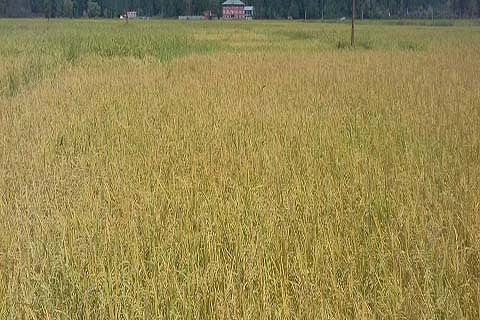Rice is the staple food for majority of the inhabitants ofKashmir valley and its cultivation has been part of our culture for long. Inspite of its importance in our daily life, we have always been deficit of ricegrains and import significant portion of our requirement from other states.
To attain self-sufficiency in food production and to cater to the needs of increasing population, we need to increase production of rice and other food crops within our valley.
The deteriorating condition of national highway connecting Kashmir valley with other states and its frequent closures during winter has exposed us to shortage of many food items and very high escalation in their cost especially during prolonged winters.
Other important factors which contribute to the existing scenario of deficiency in food production include conversion of paddy land for non-agricultural purposes such as construction of new roads or railway tracks through paddy fields, rampant expansion of residential colonies and commercial complexes due to lack of a healthy housing policy and bringing more and more paddy land under more remunerative horticulture sector.
We also see an array of brick kilns erected on paddy fieldsjust from the beginning of Budgam district when we travel by train fromSrinagar to Baramulla and also alongside the different highways.
This situation puts onus on the rice growers and other stakeholders to increase its production from the existing area under cultivation, which is shrinking day by day.
Scientists at Mountain Research Centre for Field Crops (SKUAST-Kashmir) located at Khudwani, Anantnag are making efforts to breed high yielding rice varieties and evolve the management practices to have better production from existing area.
As of now we have got some remarkably high yield potential varieties for use by the farmers. These include Shalimar Rice-1, Shalimar Rice-3 and Shalimar Rice-4 for the plains of Kashmir valley and Shalimar Rice-2 for those areas in plains facing water logging problems. In higher belts, above 2000m above sea level, farmers shall use varieties Shalimar Rice-5 and K-332.
Apart from these high yielding varieties, farmers in someniche areas use some high value land races of rice which fetch them betterremuneration owing to their high quality parameters. Such varieties may notyield as high as other improved varieties but their high market value not onlycompensates for the lower yields but fetches better income to their growerscompared to the traditional varieties.
One of the commendable success story in rice research during recent years is the revival of a well known aromatic local land race Mushka Budji in villages Sagam, Tangpowa, Danwethpora and some neighbouring villages of identical ecology under the guidance of SKUAST scientists, which not only made the rice growing a profitable entrepreneurship but also earned for the farmers of the area the prestigious “Genome Community Saviour Award- 2016”.
In yet another similar drive, rice scientists of SKUAST-Kashmir revived cultivation of red rice Zag or Lunda in Gomal and adjoining villages of Tangdar (Karnah) tehsil of Kupwara district to actually revive the hope of profitability for the rice growers of this remote area, besides wining once again the prestigious “Genome Community Saviour Award- 2019” for the farmers of the area.
Zag or Lunda varieties also offer a nutrient rich staple food to the consumers. Having appreciable quantities of zinc and iron, Zag rice is very useful staple especially for pregnant women.
These success stories substantiate to our view that rice growing is not just for food security but it has potential for economic and nutritional security as well.
Ultimate benefit of these improved varieties and otherrecent technologies can be reaped only when these percolate down to thefarmers’ level. To achieve this goal and to bring valley into an era of foodsecurity and self sufficiency, all the stakeholders need to gear up especiallythe field functionaries of concerned departments who have to transfer thistechnology to its end-users.
The authorities in the government have to ensure that thetechnology generated in the University reaches the farmers and also there is acontinuous flow of feedback from the farmers’ field to the research centres towork out the scientific solutions for their problems.
One of the most important factors to help increase in rice production is that farmer should get right kind of variety for his particular ecology. If the farmer does not choose the right variety of seed, he cannot reap full benefits of his season-long hard work.
The seeds of all the varieties suiting different ecologies are available at KVKs of the University and also at MRCFC Khudwani Anantnag where the scientists of SKUAST-K are always available for the guidance of our revered farmers to help them to bring prosperity in our valley.
(The author is Associate Director Research, MRCFC SKUAST-Kashmir. Call on 9419538677)






